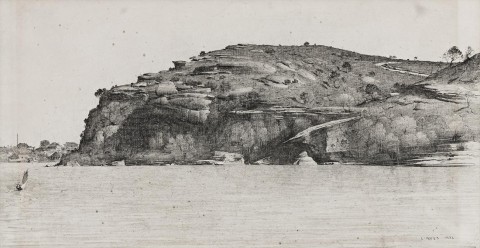BALLS HEAD, SYDNEY HARBOUR, 1932
LLOYD REES
pencil on paper
14.0 x 27.0 cm
signed and dated lower right:
L. REES 1932
Probably: Artarmon Galleries, Sydney
Private collection, Sydney
Balls Head, 1931, pencil on paper, 20.3 x 25.0 cm, in the collection of the Art Gallery of New South Wales, Sydney
The late 1920s had been a very difficult time for Lloyd Rees personally. The death of his first wife in 1927 was followed by a period of deep depression. However, in 1930 the artist again found love and it was on a bus trip to visit his fiancé Marjory, who became his wife of 57 years, that a major development in his working method occurred. As Rees explained in his autobiography:
'It was at Pennant Hills that a new movement in my work began. It was a rolling open landscape then and could be reached by bus from Parramatta and it was there that I tried to seriously resume painting. Physical tiredness was still affecting me and one day I tired early and was faced with a long wait for a Parramatta bus. I took a book of drawing paper from my satchel, unused because of an absurd hangover from my student days that pencil was a soft medium which must only be used on softer papers. The paper in this book was ivory smooth – the type recommended for commercial pen drawing, ensuring very black, very clean lines. Almost thoughtlessly, I began working, content in my tired state to merely outline the contour of hills and fences and trees of several varieties, with houses and sheds nestling among them or standing clear’.1
The discovery of this specific pencil and paper combination marked the beginning of an inspired period in which Rees committed himself solely to drawing, a marathon effort which extended well into the mid-1930s. Importantly for Rees a group of these drawings was accepted for exhibition by the progressive Society of Artists and in a further boost to his confidence, in 1931 the National Art Gallery of New South Wales, Sydney became the first such institution to purchase one of the drawings, Balls Head, Sydney Harbour, 1931, for the permanent collection.
Many of the drawings from this time depict scenes around Sydney Harbour, but it was Balls Head to which Rees returned again and again. ‘Balls Head was a favourite early motif. Drawn from the distance, from sea level at Blues Point … the series of drawings gives Balls Head a mass equivalent to its psychological effect. Its rocky formation is drawn as with a chisel. The first drawing captures the full drama of the forms, in later versions he elaborated the foreground’.2
The delicate detail in Rees’ drawings of this period is staggering; by any measure they are as close as any Australian artist may ever come to the achievements of the Italian masters he so much admired. Rees’ nuanced and inspired drawing is heightened by the virtuosity of his technique. Surprisingly, the breadth of tone and line is not achieved by a range of differing lead pencils – but by using only one. His distinctive technique of sharpening the pencil against the tooth of the paper while using it horizontally to shade, meant that the shift from tone to line was seamless and in no small way helped Lloyd Rees to achieve the fluid nature of these masterful drawings.
1. Rees, L., Peaks and Valleys, Angus & Robertson, Sydney, 1985, p. 189
2. Free, R., Lloyd Rees, Lansdowne Press, Sydney, 1972, p. 42
HENRY MULHOLLAND
